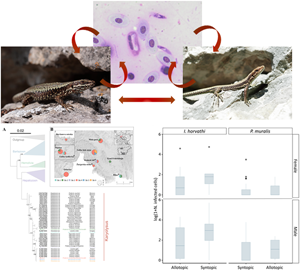Published online by Cambridge University Press: 28 September 2021

In parasite–host interactions host species may differ in their ability to fight parasitic infections, while other ecological interactions, including competition, may differentially alter their physiological state, making them even more susceptible to parasites. In this study, we analyse the haemogregarine blood parasites infecting two competing lizard species, Iberolacerta horvathi and Podarcis muralis, and explore host–parasite relationships under different host competition scenarios. Both species were infected with haemogregarine parasites belonging to the genus Karyolysus. Using the 18S rRNA gene, six new Karyolysus haplotypes were identified clustering with other Central and Eastern European samples, and widely shared between both lizard hosts. Haemogregarine infections were detected at all sampled sites with over 50% of individuals parasitized. Overall, I. horvathi was more frequently and also more intensely parasitized than P. muralis, with higher infection rates observed in syntopy. Males of both species tended to be more frequently infected and showed a higher infection intensity than conspecific females. The results suggest that parasitisation by haemogregarines may be relevant in the dynamics of the competitive relationship between these lizard species. More studies, including immunological response analysis, and the identification of the vectors are needed to better understand host–parasite relationships and competition.